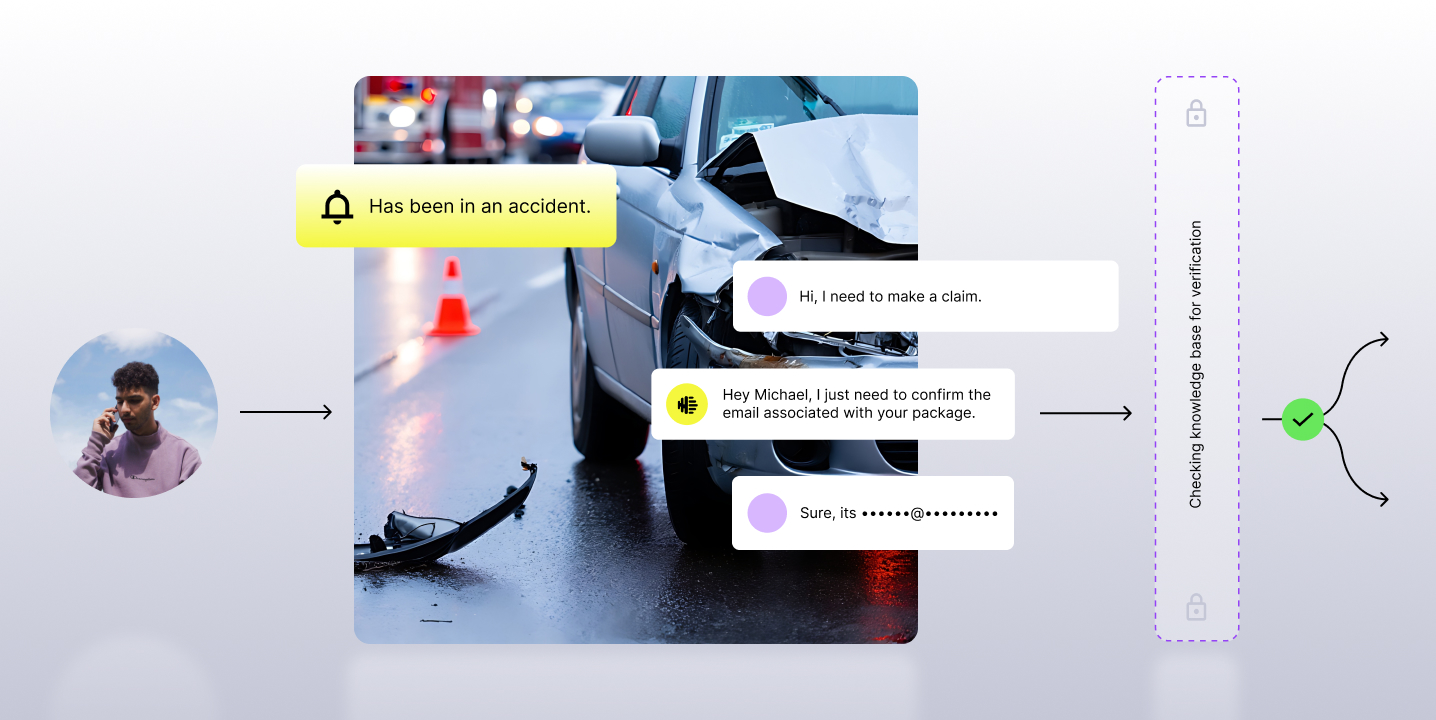Today’s contact center environment is ever-changing, and agents face the rising challenge of continuously adapting to customers' evolving needs.
Research shows that 85% of customers are more likely to stay loyal to a company that provides proactive customer service, making this adaptation more essential than ever.
Staying ahead means embracing innovative technologies that revolutionize operations and elevate customer service.
One such game-changer is real-time call center speech analytics, a cutting-edge solution that offers instant insights into customer interactions.
At the forefront of this revolution is Observe.AI, with its pioneering real-time speech analytics solutions tailored for contact centers and call centers.
In this article, we will explore the significance of real-time human speech analytics in contact center operations, delve into its transformative impact, and uncover how Observe.AI is leading the way in this innovative field.
What is real-time speech analytics?
Real-time speech analytics is a relatively recent development in the contact center space and differs from text analytics forms.
Real-time speech analysis empowers contact centers to proactively address issues as they arise, leading to:
- Faster issue resolution
- Improved agent performance
- Enhanced customer loyalty
It enables contact centers to analyze omnichannel customer interactions as they happen, providing immediate insights into customer sentiments, preferences, and pain points across different formats, including social media and mobile apps.
How does real-time speech analytics work?
What makes this form of speech analytics unique is that it happens in the moment, so insights and actions occur simultaneously, leading to instant improvements in service and satisfaction. Real-time analytics are what power this AI-driven technology, as interactions are recorded, analyzed, and adapted at critical touchpoints, as they happen.
Real-time speech analytics harnesses the power of artificial intelligence and natural language processing (NLP), enabling contact centers to stay ahead of the curve with their quality management and customer support. As calls come in, they are transcribed and monitored, with the real-time speech analytics software monitoring for customer sentiment, compliance, and much more. Agents can then receive assistance in the moment to resolve issues and boost customer satisfaction.
Real-time vs. post-call analytics
Unlike traditional analytics methods, which involve manually reviewing recorded customer call transcriptions after the fact, real-time speech analytics allows contact center agents and supervisors to make informed decisions in the moment. However, it’s important to note that post-call analytics still plays a critical role in call center operations and customer experience. Post-interaction AI solutions, like those from Observe.AI, remain crucial components of your QA process. After-the-fact analytics like these can help solve larger, more complex issues, and can help contact center managers build and scale effective training programs.
Key benefits for contact center operations
Wondering why you should consider real-time speech analytics with live calls in your operations in addition to post-call speech analytics models?
Here are some of the key benefits:
Enhanced customer experience
By analyzing customer conversations in real time, call centers can quickly identify customer needs, preferences, and sentiments. This allows agents to tailor their responses accordingly, leading to more personalized interactions and higher customer satisfaction without the need to manually transcribe and understand them later.
Improved agent performance
Real-time speech analytics provides agents with instant feedback functionality and guidance during customer interactions. Agents can receive prompts for upselling opportunities, reminders for compliance requirements, or suggestions for resolving customer issues more effectively. AI-powered technology can provide agent assist features, which improves agent performance on scorecards and productivity metrics, promising quality assurance.
Immediate customer insights
With real-time speech analytics, contact center supervisors and managers gain immediate visibility into customer interactions as they unfold in the customer journey. They can then identify trends, patterns, and emerging issues in real time, allowing for proactive intervention and problem-solving.
Reduced customer churn
Being faster on the draw with issue resolution means your team allows less time for customers to have a change of heart. Today’s savvy customers want instant gratification, and real-time speech analytics is part of a strategy that empowers your agents to give it to them.
Lower operational costs
Time is money, and the faster you can resolve issues, the faster you can move onto serving the next customer. You’ll save plenty of time with real-time speech analytics and will get to the root causes of service gaps and other issues more quickly. You may also lessen time spent on post-call analytics and agent training, which can also save you both time and money.
Observe.AI’s solutions are specifically designed to address these benefits in a contact center environment.
By integrating advanced artificial intelligence and machine learning capabilities, Observe.AI empowers contact centers to extract valuable insights from every customer conversation in real time.
Key components of real-time speech analytics
Wondering what goes into the real-time speech analysis process? Here are the details:
Live transcription
Data is captured and immediately transcribed during every live call. All spoken words are recorded as text with a high level of accuracy.
Keyword analysis
Natural language processing (NLP) and AI-driven technology is used to analyze the text based on certain keywords or phrases, which can pinpoint customer sentiment or identify issues with compliance.
Agent assist monitoring
Supervisors gain insights from speech analytics as they happen, and can intervene or escalate interactions as needed.
Regulatory compliance checks
Compliance violations are flagged in real time, and can be corrected or handled right away to avoid fines or other negative consequences.
Implementing real-time speech analytics
Implementing real-time speech analytics into phone calls in your contact center requires careful planning and execution to ensure its successful integration and adoption.
Here’s a guide for contact center leaders to refer to:
Technology selection
Research and evaluate different real-time speech analytics solutions available. Consider factors such as accuracy, scalability, compatibility with existing systems, and vendor reputation. For example, Observe.AI offers robust real-time speech analytics capabilities tailored to contact center needs.
Integration with existing systems
Assess your contact center’s technological infrastructure and identify potential integration challenges. Work closely with your IT team and the chosen vendor to ensure seamless integration with existing CRM systems, call recording software, and other relevant tools. Observe.AI provides flexible integration options and dedicated support to streamline the integration process.
Staff training and change management
Invest in comprehensive training programs to familiarize agents, supervisors, and other staff members with the new real-time speech analytics technology. Ensure they understand how to use the analytics platform effectively and interpret its insights. If needed, implement change management strategies to address any resistance to adopting new technology and emphasize its benefits to their roles.
Continuous monitoring and optimization
Once implemented, regularly monitor the performance of the real-time speech analytics solution and gather feedback from users. Identify areas for improvement and optimization, such as refining speech recognition models, customizing dashboards, and updating training materials. Observe.AI offers ongoing support and analytics expertise to continuously optimize your real-time speech analytics strategy.
By following these steps and leveraging the capabilities of advanced real-time speech analytics solutions like Observe.AI, contact center leaders can effectively implement this and unlock its full potential in enhancing customer experiences and driving operational efficiency.
Navigating challenges in real-time analytics adoption
While real-time insights from speech analytics offer significant benefits, contact centers may encounter challenges during the adoption process.
Here are some of the common hurdles and solutions to ensure smooth implementation:
- Data privacy and regulatory compliance: One of the primary concerns when implementing real-time speech analytics is ensuring compliance with data privacy regulations such as GDPR and CCPA. Partner with a trusted vendor like Observe.AI, which prioritizes data security and compliance, offering features like automated redaction and encryption to safeguard sensitive customer information.
- Integration complexity: Integrating real-time speech analytics into existing contact center systems can be complex, requiring compatibility with various platforms and technologies. Observe.AI offers seamless integration with leading CRM systems, call recording software, and other tools commonly used in contact centers, minimizing integration challenges and streamlining the process.
- Staff resistance to change: Resistance from agents and staff members accustomed to traditional workflows and processes can hinder the adoption of real-time speech analytics. To combat this, implement comprehensive training programs and change management initiatives to educate staff about the new technology's benefits and address any concerns they may have. Observe.AI provides training resources and ongoing support to ensure smooth adoption and user satisfaction.
By proactively addressing these challenges and leveraging the expertise and support of a trusted partner and speech analytics software like Observe.AI, contact centers can overcome obstacles and successfully implement real-time speech analytics to drive improvements in customer service and operational efficiency.
Enhancing agent performance with speech analytics
Did you know that 67% of support leaders believe they are gaining value from their automation efforts?
Real-time speech analytics tools revolutionize agent performance by providing immediate feedback on customer interactions. This enables agents to make real-time adjustments and improvements. With Observe.AI’s advanced tools and features, you can make this feedback loop seamless and effective.
Among service reps, 79% believe AI tools will help them access and use data about consumers quickly, boosting their service times.
By leveraging real-time speech analytics, agents receive instant insights into their conversations, including sentiment analysis, tone detection, and key performance indicators (KPIs). This allows them to adjust their approach in the moment, more effectively address customer concerns, and enhance overall interaction quality.
Observe.AI’s platform empowers agents with actionable feedback delivered directly within their workflow. This instant feedback mechanism offers suggestions for improvement and highlights areas of strength, fostering continuous learning and improvement. It drives agent performance to new heights while ensuring consistently excellent customer experiences and elevated CSAT scores. In fact, 73% of support leaders believe customers will expect AI-assisted customer service in the next five years.
Real-time speech analytics are pivotal in equipping sales and service representatives with enhanced objection-handling capabilities and a deeper understanding of customer sentiment during calls. This leads to more effective outcomes, enabling quicker onboarding for new agents and further refining the skills of experienced ones.
By eliminating the need for manual note-taking, agents can quickly review and edit call notes, speeding up the wrap-up process. Such efficiencies contribute to improvements in first-call resolution—a critical KPI for contact centers, underscoring the profound impact of real-time speech analytics on overall operational success.
Leveraging real-time data for customer satisfaction
Real-time speech analytics is a powerful tool for understanding and enhancing customer satisfaction in contact centers.
Analyzing customer interactions in real time can help organizations gain valuable insights into customer sentiment, preferences, and pain points.
Observe.AI’s platform enables contact centers to leverage real-time data to enhance CSAT and improve service quality through various means.
For example, call center sentiment analysis tools can quickly detect customer mood or satisfaction changes during conversations. This allows agents to adapt their approach in real time, addressing concerns promptly and effectively to ensure a positive customer experience.
Additionally, Observe.AI’s real-time data capabilities facilitate proactive customer engagement. You can maximize your customer engagement, benefit from a 60% cut to your hold times, and lower average handle times.
By identifying trends and patterns in customer interactions as they happen, organizations can anticipate customer needs and preferences, enabling them to provide personalized and proactive support with higher customer retention and lower customer churn.
Lead the way in AI-powered contact center innovation with Observe.AI
Real-time speech analytics stands at the forefront of contact center innovation, driving more excellence in customer service and better operational efficiency.
Observe.AI is committed to empowering contact center leaders like you with the right technology and actionable insights.
Our real-time speech analytics platform provides the tools and capabilities needed to revolutionize contact center operations, from improving agent performance to delivering exceptional customer experiences.
Take the lead in contact center innovation by exploring our offerings today.
Discover how our advanced analytics solutions can transform your contact center, enabling you to stay ahead of the curve and drive success.
















